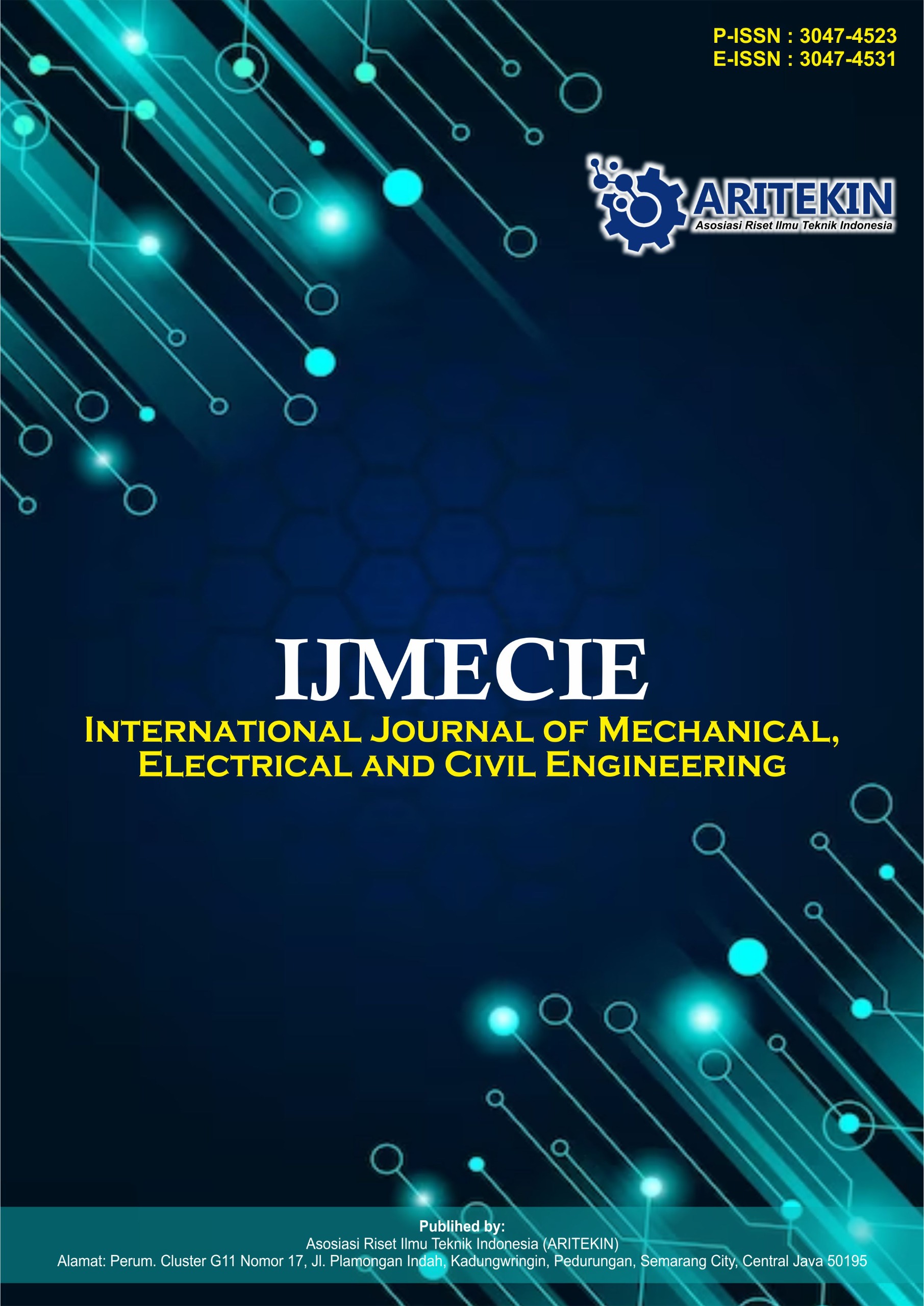Study about Electrical Current Solutions Using the MATLAB Matrix Inverse Method and MATLAB Gauss-Jordan Method
DOI:
https://doi.org/10.61132/ijmecie.v2i3.279Keywords:
Gauss-Jordan Elimination Method, linear circuit systems, Matrix Inverse MethodAbstract
This study investigates the solutions of electrical current in linear circuit systems using two numerical methods implemented in MATLAB: the Matrix Inverse Method and the Gauss-Jordan Elimination Method. The objective is to analyze the effectiveness, accuracy, and computational efficiency of both techniques in solving systems of linear equations derived from Kirchhoff's laws. Several circuit models with varying levels of complexity are tested to compare results obtained from each method. The findings indicate that both methods yield consistent solutions, although differences in computational steps and processing time are observed. This research highlights the practicality of MATLAB as a powerful tool for electrical circuit analysis and provides insights into the selection of appropriate numerical methods for solving engineering problems.
References
H. A. H. Nasution, Z. Lubis, and B. Satria, “An Analysed Design Of Charger Automatic Battery Based On Thyristor,” J. Sci., vol. 13, no. 03, pp. 695–710, 2024.
N. Niati, R. C. Murti, and W. S. Hastuti, “@article{nuriyah2024analyzing, title={Analyzing students’ conceptions in simple electric circuits topic using four-tier diagnostic test}, author={Nuriyah, Syifa and Winarno, Nanang and Kaniawati, Ida and Fadly, Wirawan and Sujito, Sujito}, journal={Journa,” J. EDUSCIENCE, vol. 12, no. 1, pp. 171–181, 2025.
S. Nuriyah, N. Winarno, I. Kaniawati, W. Fadly, and S. Sujito, “Analyzing students� conceptions in simple electric circuits topic using four-tier diagnostic test,” J. Res. Instr., vol. 4, no. 1, pp. 295–313, 2024.
M. Haryanti, A. Nugroho, B. Yulianti, and Y. Dewanto, “Transfer Function and Transient Response Analysis of Active Inrush Current Limiting Circuit on P-MOSFET with Equivalent RLC Series Circuit Load of Inverter,” Ranah Res. J. Multidiscip. Res. Dev., vol. 6, no. 3, pp. 299–306, 2024.
R. Rahmaniar, N. Lubis, A. Junaidi, and I. Fahreza, “Integration of Electrical Conductivity Concept in Measurement and Instrumentation Learning: Case Study on the Use of Soil Fertility Monitoring Tool for Electrical Engineering Students,” AL-ISHLAH J. Pendidik., vol. 16, no. 4, pp. 4915–4930, 2024.
E. Kurniadi, A. Hidayat, S. K. Handayanto, E. Supriana, T. Mayasari, and others, “Conflict between physical analysis and mathematics causing failure: A case on diode circuits,” Momentum Phys. Educ. J., vol. 8, no. 2, pp. 239–248, 2024.
M. S. Purbiananta, “Application of Half-Uncontrolled 3-Phase Rectifier Circuit for Wave Analysis,” J. Electr. Mar. Its Appl., vol. 2, no. 2, pp. 1–8, 2024.
M. Komarudin and E. Sutadji, “Widiyanti.(2024). Effectiveness of the EPI Electrical Media to Electrical Diagram Read Ability,” Educ. Adm. Theory Pract., vol. 30, no. 3, pp. 17–27.
E. Triani, M. Maison, and N. Nazarudin, “DIAGNOSING STUDENTS’MISCONCEPTIONS OF DIRECT CURRENT ELECTRICAL CIRCUITS USING A FIVE-TIER ISOMORPHIC INSTRUMENT,” J. Ilm. Ilmu Terap. Univ. Jambi, vol. 9, no. 1, pp. 71–86, 2025.
R. S. Widagdo, F. A. Hermawati, and B. Hariadi, “Unbalanced Voltage Detection with Measurement Current Signature Analysis (MCSA) in 3-Phase Induction Motor Using Fast Fourier Transform (FFT),” J. Teknol. Elektro, vol. 15, no. 02, pp. 95–101, 2024.
I. Nurhidayati, A. Fitrianingsih, S. M. Siagian, and S. C. HS, “Simulation of Kirchoff’s Law In Ni-Multisim Application to Determining the Current on a Circuit,” Simulation, vol. 11, no. 03, 2024.
L. Sahara, L. Yuliati, M. Diantoro, and others, “Identification of Prospective Physics Teacher’s Problem Solving Skills: A Study on Simple Electrical Circuits Topic.,” J. High. Educ. Theory & Pract., vol. 24, no. 4, 2024.
N. K. S. Purba, S. Permana, M. Marpaung, S. Aryza, and others, “A New Analysis Detects Short Circuit Faults In 1 Phase Networks,” Int. J. Econ. Technol. Soc. Sci., vol. 5, no. 2, pp. 96–104, 2024.
P. H. Martha, S. Aryza, and A. D. Tarigan, “A Circuit Analysis Of Current Limiter Powe Supply As Charging System Protection In Batteries,” INFOKUM, vol. 13, no. 02, pp. 508–520, 2025.
R. Harjuna, S. Sutopo, and N. Munfaridah, “Learning Based on Central Idea on the Topic of Electrical Circuits to Improve Students’ Concept Understanding,” Kasuari Phys. Educ. J., vol. 7, no. 2, pp. 446–456, 2024.
I. Syawalia, T. S. Ihsani, U. Mahmudah, and others, “ANALYSIS OF THE USE OF COMPLEX NUMBERS IN THE CALCULATION OF INDUCTOR, RESISTOR, AND CAPACITOR SERIES CIRCUITS,” in Proceeding International Conference on Islam and Education (ICONIE), 2024, pp. 2477–2485.
A. Riza, D. O. Anggriawan, E. Sunaryo, and others, “Multifunctional Digital Protection Relay for Voltage and Current Disturbances in Power Networks,” Emit. J. Tek. Elektro, pp. 309–315, 2024.
J. S. Fambudi and R. A. Sobhita, “Design and Analysis of a Thyristor-Based Controlled Rectifier Circuit for Stabilization of Speed and Rotation in DC Motors,” J. Mar. Electr. Electron. Technol., vol. 2, no. 2, pp. 1–7, 2024.
M. Fikri, “Perbandingan Metode Gauss, Gauss Jordan, Iterasi Jacobi dan Gauss Seidel untuk Mendapatkan Arus pada Rangkaian Listrik,” ENERGI & KELISTRIKAN, vol. 16, no. 1, pp. 53–62, 2024.
H. Hendriansyah, R. Andini, and S. Noertjahjani, “Analisis Komparatif Metode Gauss-Seidel dan Gauss-Jordan pada Rangkaian Penyearah Gelombang Penuh dengan Filter Kapasitor,” in Prosiding Seminar Nasional Unimus, 2024.
N. Lestari, F. Nasution, and L. D. Afri, “ANALISIS KESALAHAN PESERTA DIDIK DALAM MENYELESAIKAN SOAL DENGAN METODE ELIMINASI GAUSS JORDAN,” Relev. J. Pendidik. Mat., vol. 1, no. 1, pp. 143–149, 2021.
R. R. V. Siregar, S. C. Purba, B. D. Natalia, and K. A. Zebua, “Numerical Analysis of Rice Growth Phases in Karawang using the Gauss-Jordan Elimination Method,” EduMatSains J. Pendidikan, Mat. dan Sains, vol. 8, no. 2, pp. 261–269, 2024.
Downloads
Published
How to Cite
Issue
Section
License
Copyright (c) 2025 International Journal of Mechanical, Electrical and Civil Engineering

This work is licensed under a Creative Commons Attribution-ShareAlike 4.0 International License.





